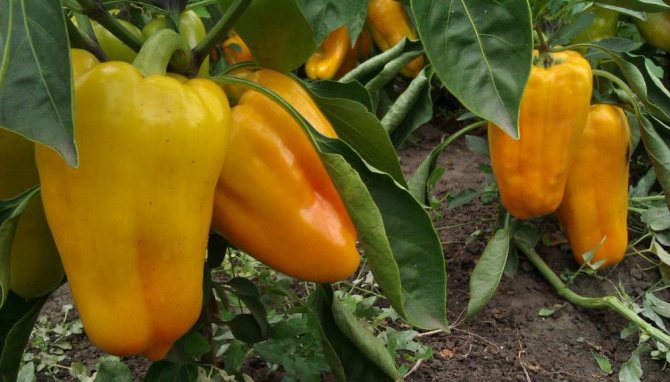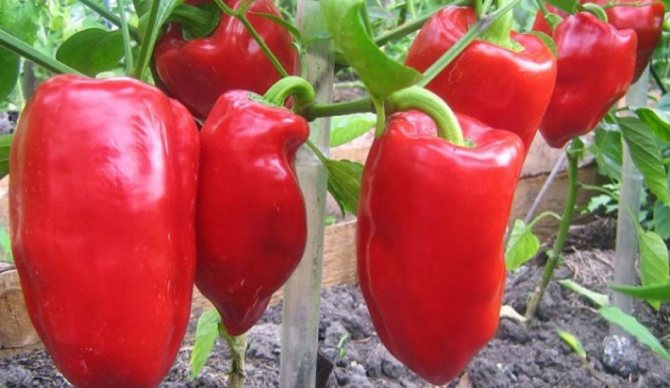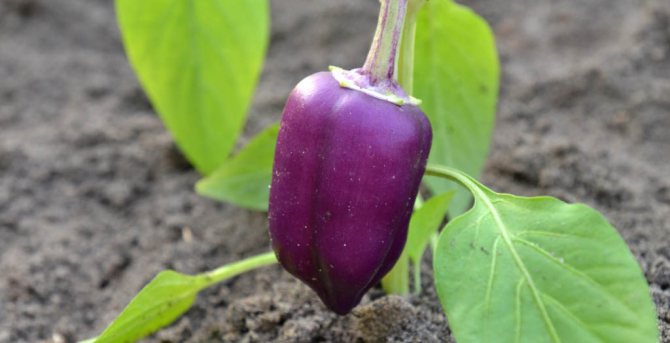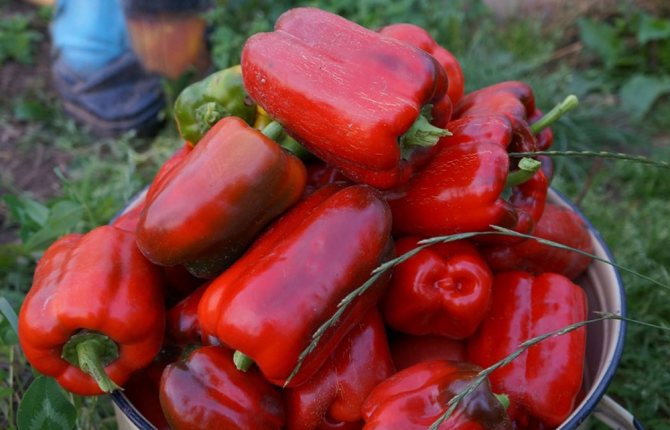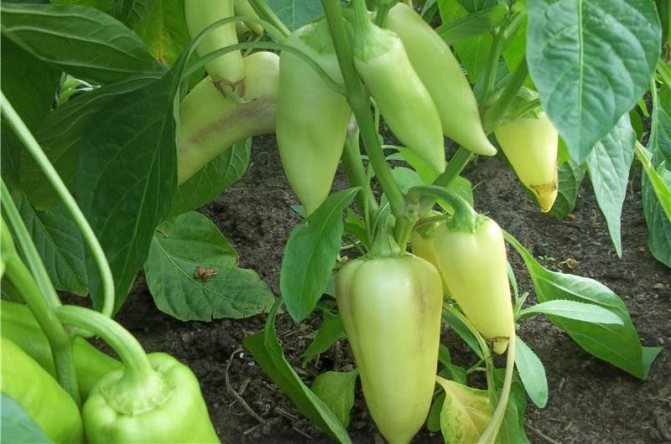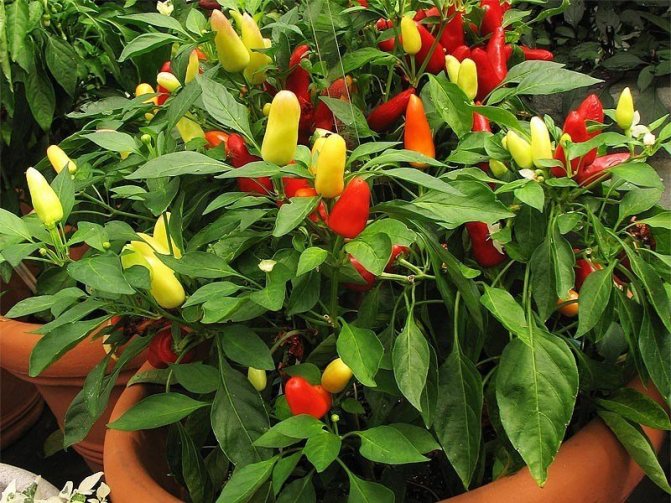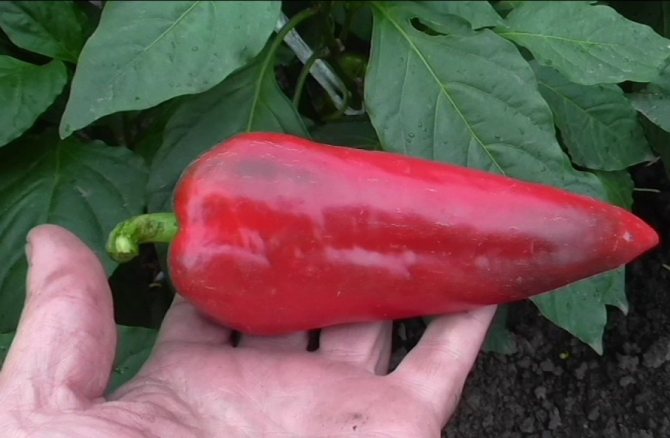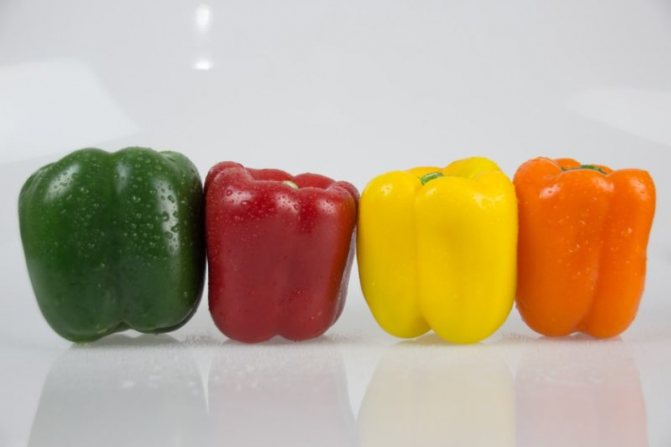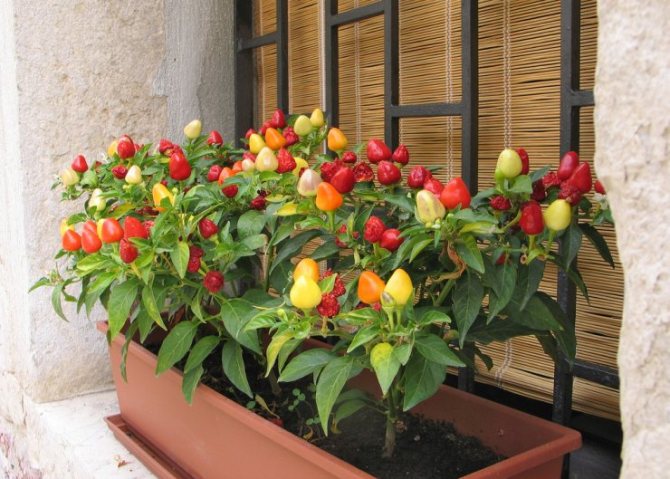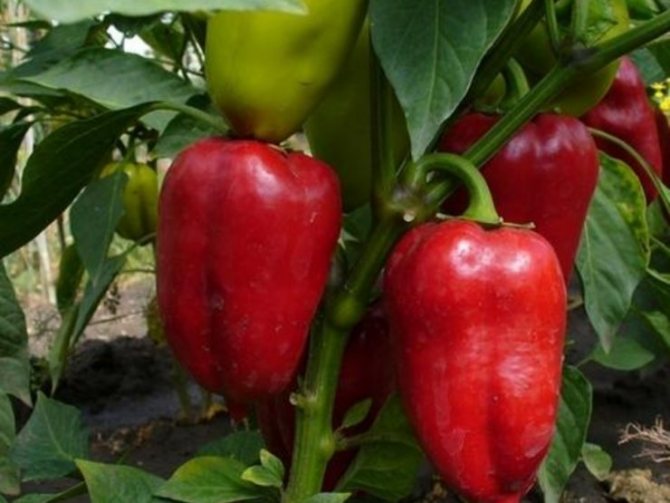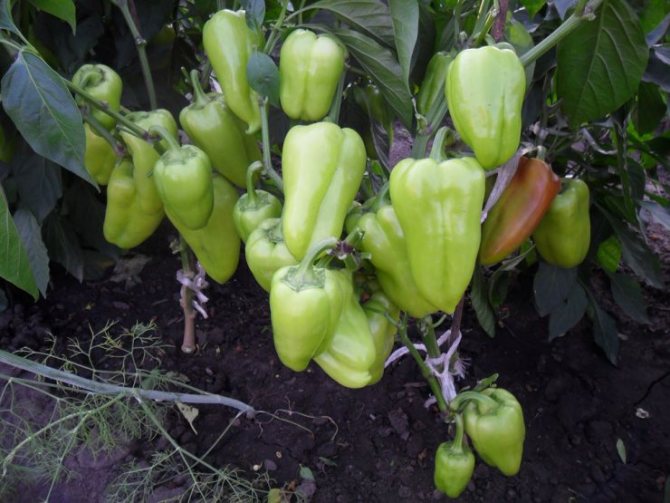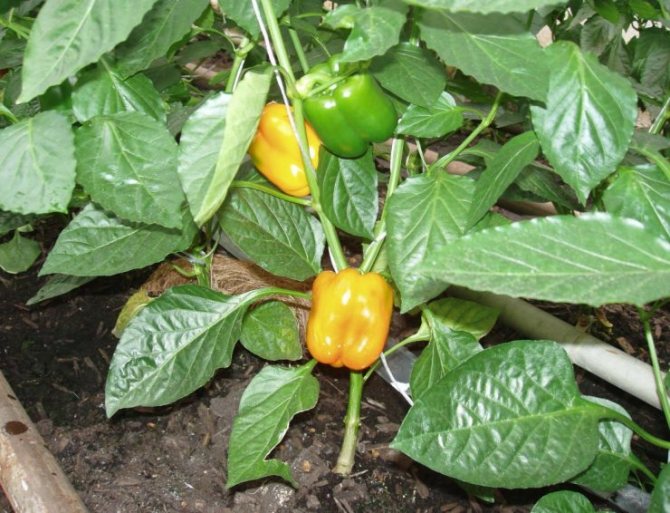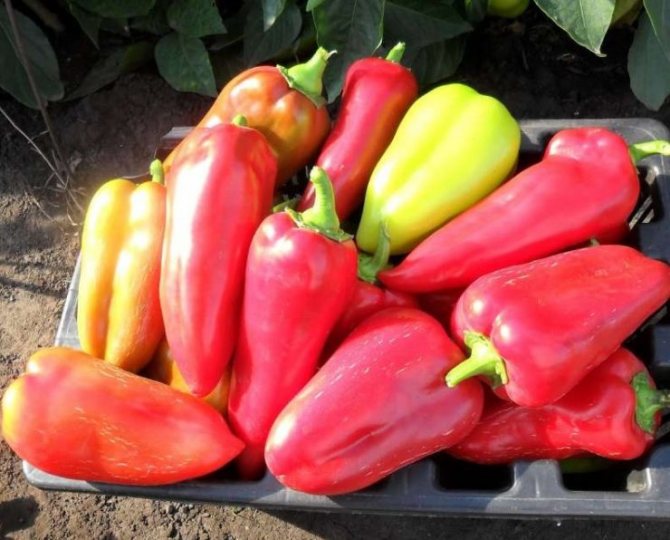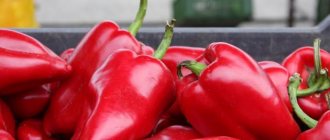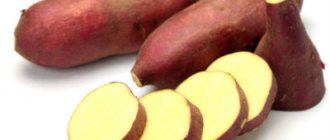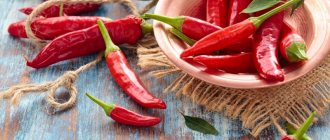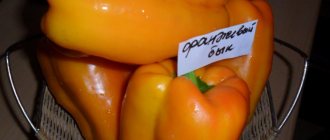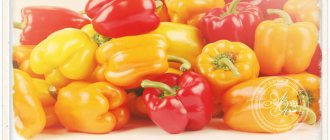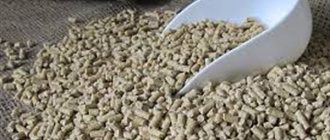Hardly any vegetable can boast so many beneficial vitamins and minerals better than bell peppers. An amazing fruit that grows like a weed in its homeland in America has become a favorite of the summer table in our area. Bright colors of a juicy, fleshy vegetable will decorate the salad so that saliva will flow!
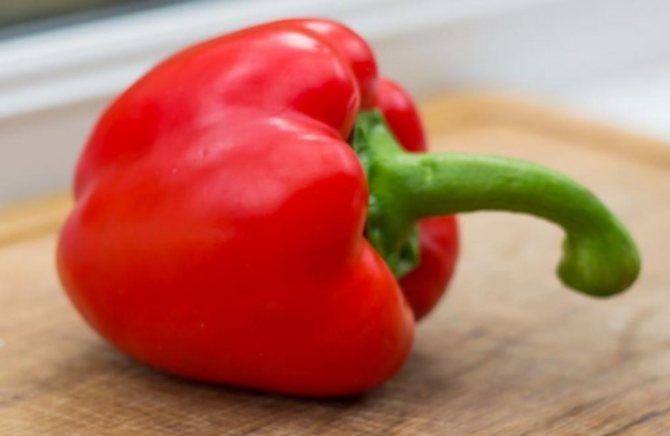
The benefits of sweet pepper are obvious, but not much is known about its dangers. Let's disassemble the amazing fruit by the bones and find out the truth about it.
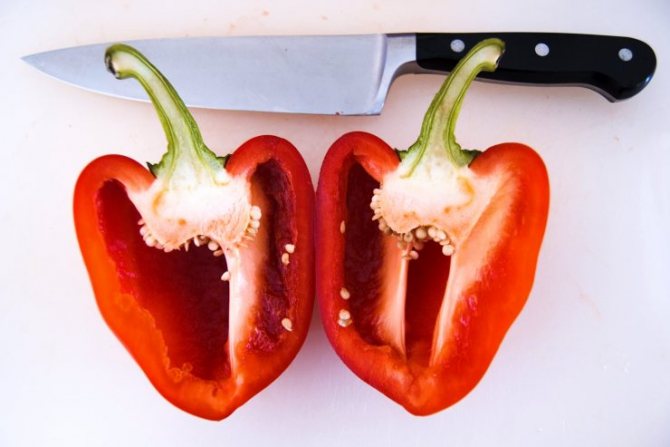

Why is pepper called Bulgarian
Solanaceous fruits appeared many centuries ago on the American continents and were cultivated by the Indians. There is information that initially the peppers were bitter, pungent and were not used for food, but were used by shamans and healers for the prevention and treatment of liver diseases, poisoning and anemia.
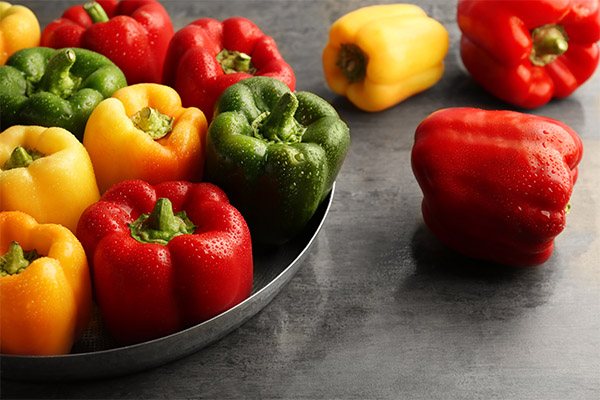

Over time, the peppers grown in the beds became more juicy and edible, the seasoning from the fruits was added to meat and fish to marinate the product and extend its shelf life, so the first prototype of the paprika seasoning appeared.
After reaching Europe, the peppers took root well in southern climates and were grown in Mediterranean countries. Initially, the world knew only bitter peppers, but with the development of selection, sweet varieties were also bred. According to some sources, today there are more than 100 varieties of this juicy fragrant vegetable.
There are several versions regarding the history of the name. One of them says that the varieties of sweet pepper we are familiar with today were bred in Bulgaria, and in Soviet times this country was the main supplier of vegetables, in particular ruddy peppers. One way or another, it is on the warm shores that the juiciest and richest crops are grown, and today delicious peppers can be obtained in greenhouse conditions.
What is the difference between paprika and bell pepper
Paprika is a seasoning made from a mixture of red peppers: hot, allspice and Bulgarian. It has a rich aroma and light pungency, therefore it is suitable for many dishes, including baby food, since it does not irritate the digestive tract as much as chili.
When buying dry paprika powder, today you can find a seasoning with the addition of other aromatic herbs and ingredients, such as garlic and basil. They began to make paprika to prolong the life of the peppers: the fruits were dried and ground into powder, thanks to which the spice retained its rich aroma and taste, and subsequently passed it on to various dishes all year round.
Sometimes under the name paprika is meant a red subtype of sweet pepper, more aromatic than its counterparts in other colors.
For male strength
Sweet pepper will be equally beneficial for men with its regular use.


Hair loss worries men more than women. Thanks to the lycopene contained in red pepper, it is possible to stop the balding process.
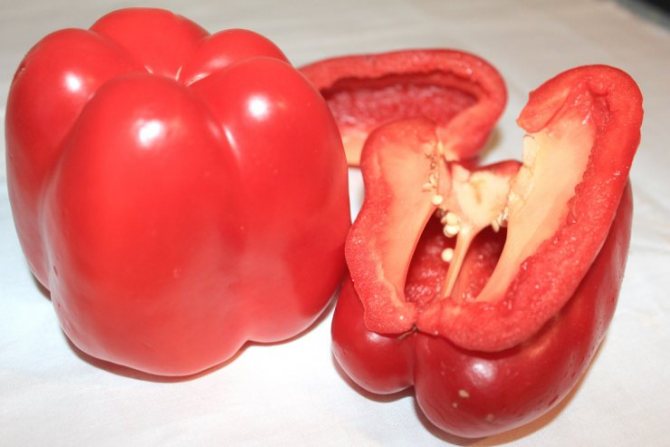

Zinc stimulates brain activity and sexual activity. That is why it should be consumed by a man of any age.
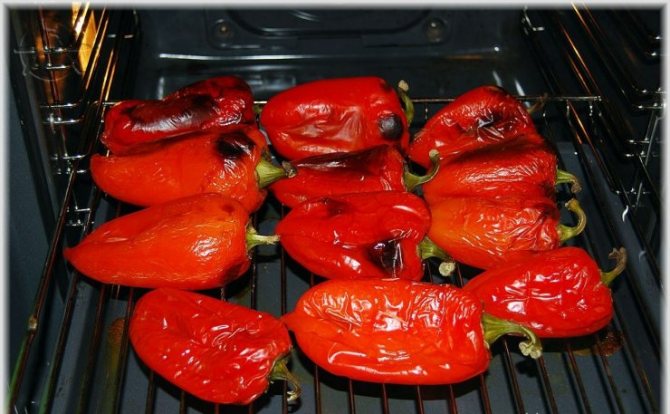

Representatives of the stronger sex are at greater risk of getting thrombosis, heart attack or stroke than women. Many of them are also experienced smokers.
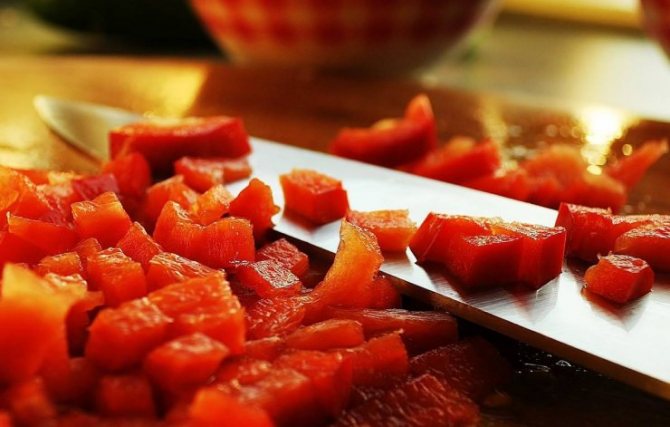

To avoid serious health problems, you need to include bell peppers in your diet every day.
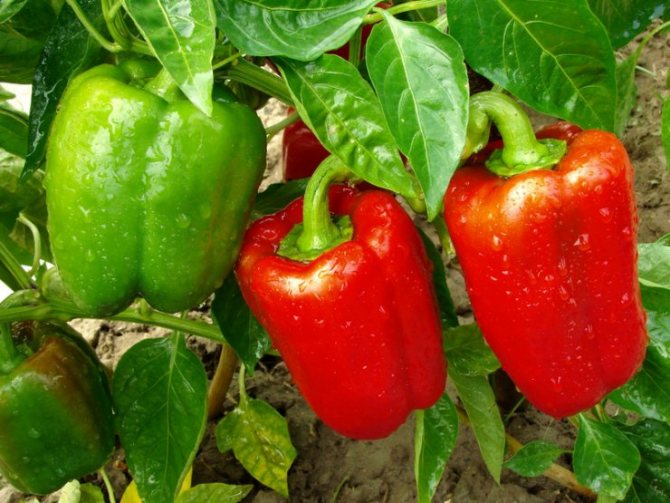

Bell peppers are a real miracle, a storehouse of vitamins and minerals on our table. It is added to dishes, salads are prepared, stuffed, fried, baked, moreover, all year round.
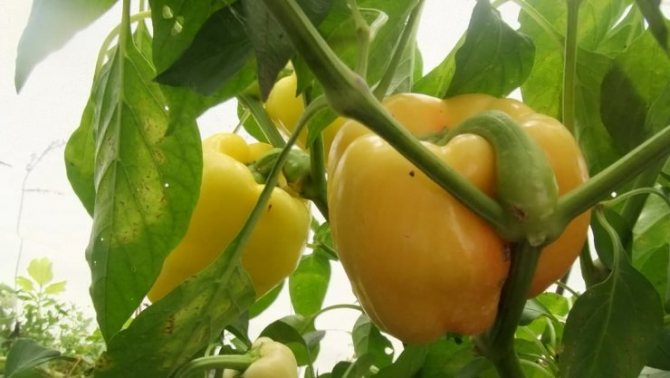

Far-sighted housewives freeze it for the winter. Cook immediately, without completely defrosting, just do not keep it in cold water for a long time, otherwise all the useful substances will dissolve in it.
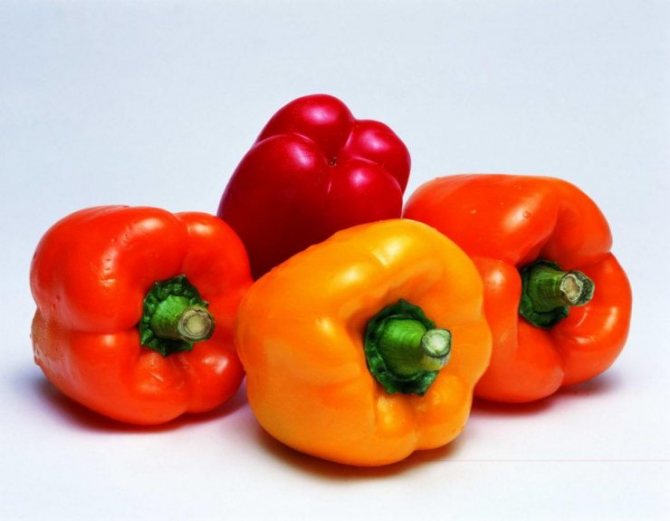

Get vitamins yourself, share about its benefits with family and friends, and the pepper will share with you its generous reserves of health.
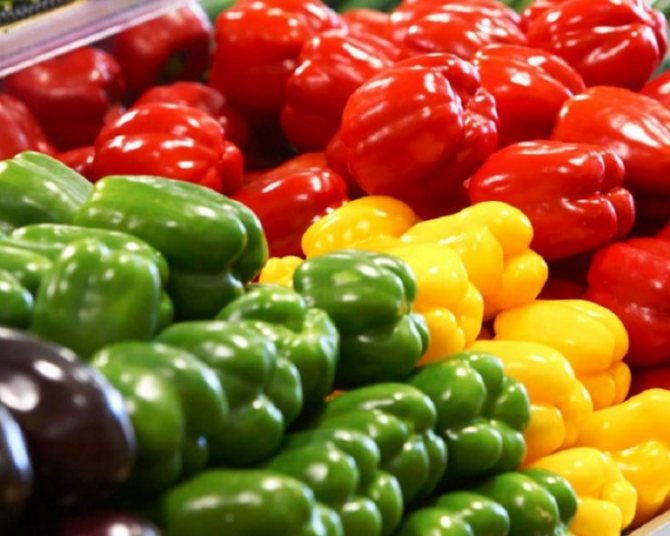

Composition and calorie content
Peppers are a low-calorie food recommended in healthy and dietetic nutrition due to their valuable nutritional properties. They are 90% water and are rich in minerals, vitamin compounds and valuable dietary fiber. There are only 0.4 g of proteins in peppers, 0.8 g of fats, and these are very small figures. Carbohydrates are about 6 g, and the energy value of bell peppers is 24-28 kcal per 100 g, depending on the variety.
The sweetest varieties are yellow and orange: they have more calories, the average content will be in red peppers, and green ones are an unsaturated variety, which has the least amount of sugar and other useful substances, it is valuable in dietary fiber and phytosterol content.
Pepper contains:
- Calcium and phosphorus, which are essential for strong bones and normal heart function.
- Potassium, which is involved in the regulation of pressure and water-salt balance in the body.
- Manganese, essential for maintaining healthy bones and blood composition.
- Sodium, essential for healthy chemical processes in the nervous and cardiovascular systems.
- Zinc and Selenium, which support hormonal health and strong immunity.
- Iron involved in the creation of red blood cells.
- Vitamin A, good for eyesight and promoting tissue regeneration, relieving inflammation and rapid healing of injuries.
- Vitamins of group B, which ensure the health of the nervous system, the protective and vegetative functions of the body.
- Vitamin C, which acts as an antioxidant and helps to cope with viral infections.
- Vitamin PP, which fights the formation of cholesterol plaques in blood vessels.
- Vitamin K, which ensures normal blood clotting.
Bitter peppers also contain antimicrobial agents, pain relievers, and toxin-removing agents.
In different varieties, the combination of nutrients may be different, therefore, it is recommended to combine colored peppers in dishes not only for the sake of improving the taste, but also for the purpose of greater benefits for the body.
Sunny yellow
The yellow fellow has a little less useful qualities, but they are not inferior in their intensity to the red one.
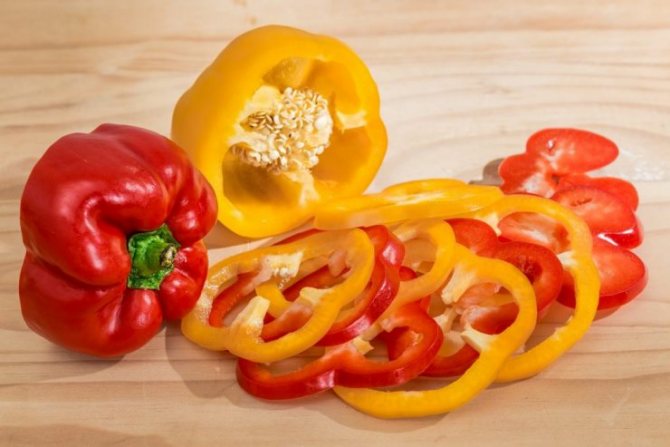

The sun fruit contains more ascorbic acid than red pepper.
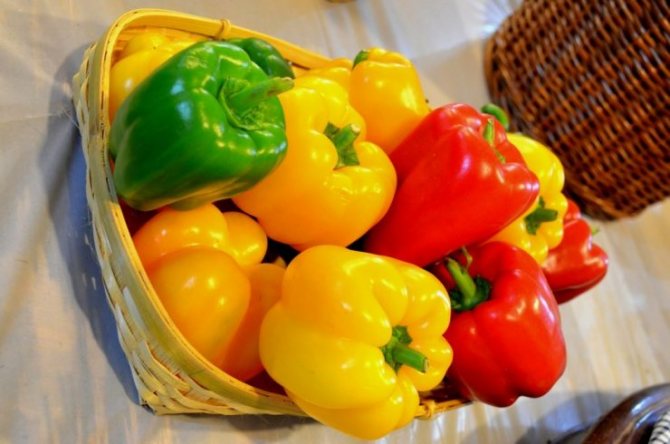

It contains more potassium, which normalizes the functioning of the heart, musculoskeletal system and nervous system.
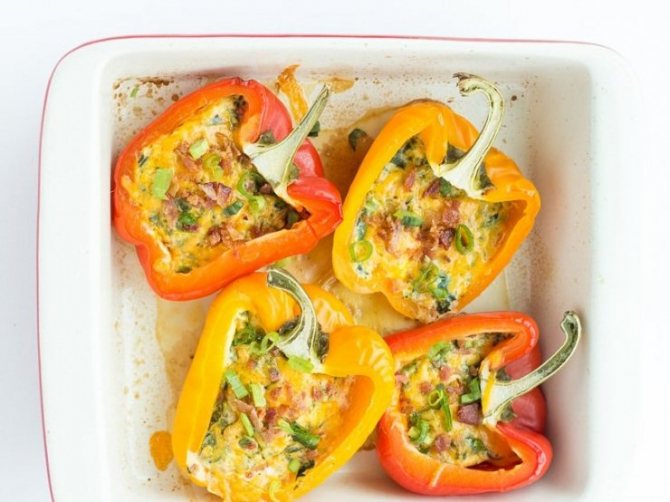

It also fights sclerosis and prevents the accumulation of sodium salts in the vessels. And therefore, yellow pepper is recommended to be eaten by the elderly.


Iron in yellow fruits is involved in the formation of hemoglobin.


For those who want to be forever young, the yellow vegetable slows down the aging process. Thanks to vitamin B, it also prevents strokes and heart attacks.


Why is Bulgarian pepper useful?
General benefit
A light and nutritious vegetable is essential for saturating the body with vitamins. Of course, there is nothing irreplaceable in the product, but it perfectly diversifies the table and brings a rich portion of useful elements.
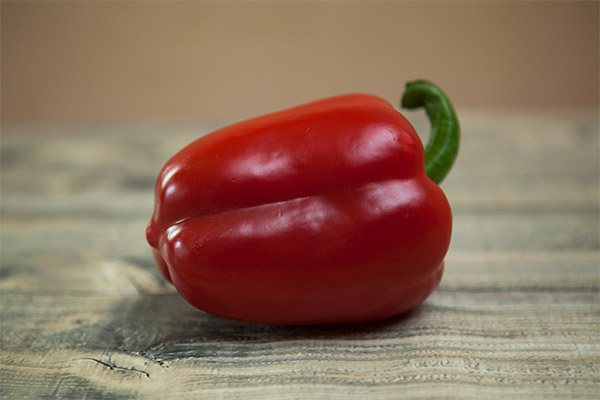

Bell peppers contain a fairly tough fiber, which is useful not only for cleansing the intestines, but also for satisfying hunger after a meal. The vegetable is easily digested, creating a feeling of fullness, which is why it is often included in the diet for weight loss.
Pepper helps to maintain body strength and stay in good shape. The juicy fruit brings with it a sufficient amount of liquid, so the digestion process is comfortable.With various characteristics of the body, pepper can show its benefits.
For women
For example, for women, it is useful for maintaining a slim figure and fighting body fat. Peppers disperse the blood, triggering active digestion and speeding up metabolism.
Another useful property of peppers is to improve skin condition. The constant use of this product will relieve rashes, peeling, traces of fatigue on the skin, restore elasticity and a healthy complexion, promote the elimination of toxins and slow down oxidative processes.
Pepper masks strengthen not only the skin, but also the hair, helping to fight breakage and restore the balance of life-giving moisture.
Pepper also strengthens the nervous system, helping to maintain balance and maintain high performance even in PMS and during menopause.
For men
For the stronger sex, pepper is useful for its ability to keep the body in good shape - this is useful for strength training. In addition, it contains a sufficient supply of selenium and zinc, which are necessary for the maintenance of male sexual health and the ability to have children.
Sweet pepper is often used in the fight against impotence to restore blood circulation and relieve inflammation in the pelvic organs.
Pepper is used to protect against baldness: a decoction from inedible parts of the plant is used for this.
During pregnancy
During pregnancy, bell peppers will be helpful in maintaining normal digestion and regular bowel movements. It can help prevent constipation, bloating, and other discomfort.
In addition, the vitamin and mineral composition of bell pepper will provide the fetus with the necessary elements for the formation of the nervous system and internal organs, support the normal level of hemoglobin and healthy immunity of the mother.
Thanks to the use of peppers, stamina will increase and mood will normalize. This product is safe to include in a healthy diet during pregnancy. It goes well with protein foods and other healthy foods.
Video:
how to eat right during pregnancy Expand
When breastfeeding
When breastfeeding pepper, it is advisable to use small portions and carefully monitor the well-being and reaction of the child, since the product sometimes causes allergies. Some pediatricians recommend returning the vegetable to the diet after 3 months of feeding. In this case, it is advisable to give preference to a thermally processed product, since potential allergens are destroyed in it, and the fiber becomes softer.
The benefits of pepper during this period are to maintain a healthy composition of the mother's blood and high quality milk, eliminate toxins from the body, rejuvenate, and quickly recuperate. If your baby has a rash, you should consult a pediatrician.
For kids
Pepper is also useful for children. It is introduced into the baby's diet only after a year, first in the form of steamed puree and only later as a whole. Fresh fruits can be given to a child after three years, if no intolerance is found.
Hot peppers are given to children very carefully in minimal quantities so as not to irritate the intestinal mucosa and to allow the digestive system to fully form and strengthen.
In a child's diet, pepper is important for supplying the body with a vitamin complex, good digestion, strengthening bones, developing the cardiovascular system, maintaining normal nervous functions, vigor and activity, protecting and forming strong immunity. Also, the vegetable provides the prevention of constipation, the maintenance of good vision and the rapid healing of abrasions, scratches and other skin lesions, which is important in the life of little fidgets.
Is it possible for pregnant or lactating women
While carrying a child, sweet pepper is not just not contraindicated, but recommended for expectant mothers.Due to the high content of vitamins and beneficial nutrients, this vegetable has an equally beneficial effect on both the expectant mother and the fetus.
The pulp of pepper contains a large amount of vitamin B9 - folic acid. It is an indispensable micronutrient for pregnant women, ensuring the healthy formation and development of the fetus. Another useful substance of particular value for future offspring is vitamin E - tocopherol. Its high concentration makes pepper equally beneficial in terms of reproductive health - for both men and women. It is called the vitamin of pregnant women, because it tends to increase fertility and have a beneficial effect on the gestation process and on the quality of the offspring. Vitamin C and iron, abundant in pepper, protect the mother and fetus from developing iron deficiency anemia.
Useful properties of pepper depending on the color
In general, the composition of peppers remains constant regardless of their shades, but some subspecies contain specific substances that are useful for various diseases.
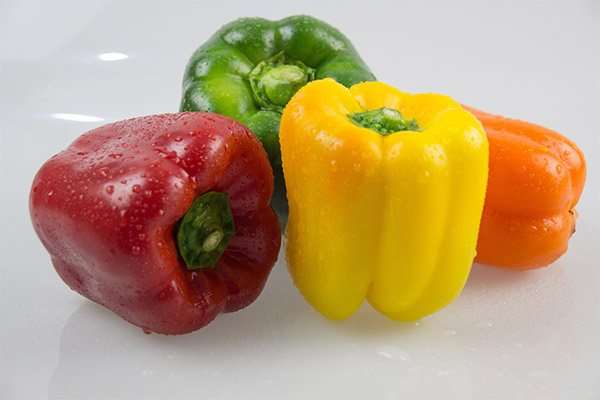

Red
Red peppers are high in vitamin C and help the body stay resistant to viruses. It strengthens the walls of blood vessels, ensuring the prevention of atherosclerosis, has an antioxidant effect. Red pepper has a positive effect on the digestive system by stimulating the production of gastric juice. Paprika helps control appetite, eliminates gastrointestinal discomfort, and helps cleanse the blood and liver.
Yellow
Yellow pepper is rich in carotene, which is responsible for visual acuity and the integrity of the skin. The use of yellow and orange peppers is useful in inflammatory processes for the early renewal and healing of the body.
Also, yellow peppers have more sugars - it satiates the body faster and helps on diets when you need to get rid of hunger.
This pepper contains more iron, which is necessary for blood formation, as well as potassium and phosphorus. The product will help maintain water balance and regulate the excretory system. The use of pepper during fitness training helps to stimulate metabolic processes and eliminate toxins, excess fluid and salts from the body.
Green
Green pepper has a low glycemic index and normalizes nervous activity. It contains phytosterols - substances that promote the elimination of cholesterol from the blood and fat metabolism in the body.
Green pepper prevents atherosclerosis and promotes weight loss. This species is usually consumed fresh to preserve its beneficial properties.
Video:
what is the use of green pepper Expand
Diet properties
The high nutritional value of sweet peppers is known to nutritionists and health professionals. Due to the large amount of water, dietary fiber and low concentration of carbohydrates, proteins and lipids, bell peppers are suitable for various categories of patients:
- diabetics;
- pregnant and lactating women;
- overweight people.
There is practically no starch in the fruits, which increases the calorie content of the product. It can be eaten instead of high-calorie fruits - grapes, oranges, bananas - due to its pleasant refreshing sweet taste and crunchy texture.
Bell peppers are a great weight loss product. It contains a large amount of water, dietary fiber and a minimum of fat. It is a low-calorie product that is useful for dietary nutrition. People who are overweight or diabetic can eat the vegetable raw and cooked without fear. Pepper pulp contains a minimal amount of vegetable protein, which makes the vegetable an easy product for the digestive system.
Nutritionists recommend eating fresh pepper, since after heat treatment it loses up to 70% of its beneficial properties. However, this does not apply to people with high acidity of gastric juice and suffering from gastritis / peptic ulcer disease.In this case, on the contrary, light heat treatment is recommended, since raw vegetables can provoke an exacerbation of gastrointestinal diseases. Ideally, it is better to eat baked or stewed peppers, use it in a vegetable stew or sauté.
Attention! Fresh pepper has a specific property - it increases the appetite. Therefore, in the process of losing weight, it is better to eat it not on your own during snacks, but to use it as a full meal - in vegetable salads, as an appetizer for the main course, for dessert.
Which pepper is healthier: sweet or bitter
It would not be entirely correct to compare sweet and hot pepper varieties with each other in terms of useful properties, since the substances that give the fruit bitterness not only have a healing effect, but can also harm.
Hot peppers help cleanse the liver and have a choleretic effect, stimulate a fast metabolism, improve blood circulation, and support brain activity. However, they should not be consumed in large quantities.
Sweet peppers, on the other hand, are safe for the body in larger portions. Its fiber allows you to remove toxins, and trace elements protect the skin from the negative effects of the sun, irritation, dryness, flabbiness and tired appearance. Bell peppers are less likely to cause allergies and contain more iron.
It is recommended to combine different types of pepper in the diet: spicy varieties are used as a seasoning, and sweet ones - as the main component in salads, stews, side dishes and soups.
Pepper traffic light
Try making a summer salad with peppers alone and it will be extraordinarily vibrant. Because the Bulgarian breeders have tried, and instead of one red pod, they bred multi-colored fruits.
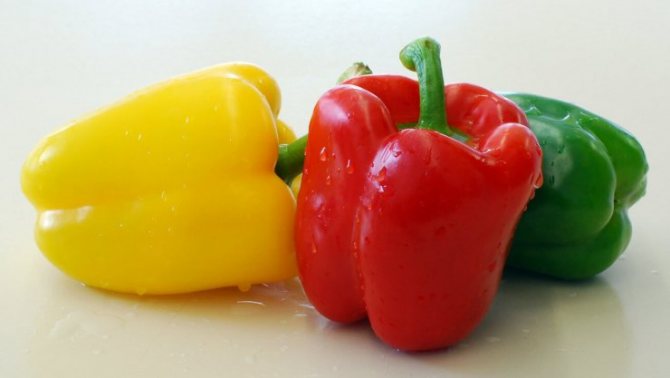

Even the most fastidious housewife will not pass by the bright splendor of peppercorns. Fruits of red, green, yellow, light salad, and sometimes purple color will definitely fall into her basket.
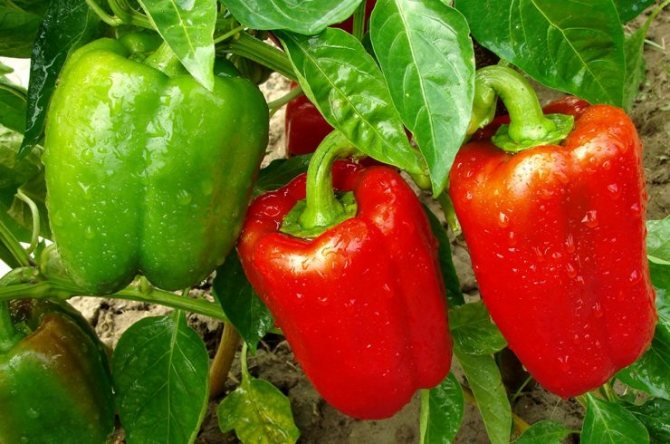

Like a traffic light, when you go from green to red, it increases the number of useful properties. Most of them are in red fruits, less in green peppers.
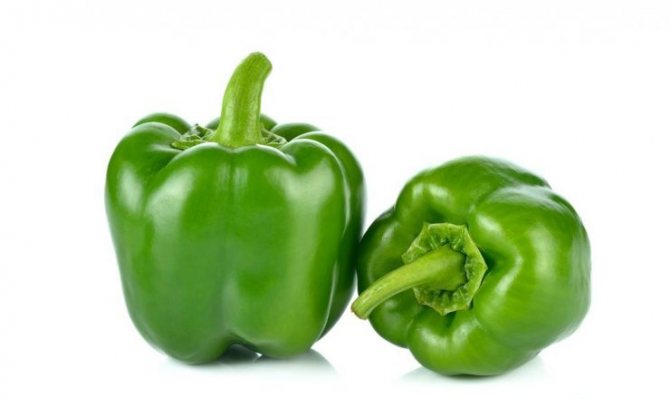

But plant foreigners are famous not only for bright colors. This vegetable is a storehouse of vitamins and minerals. Moreover, the more intense the color of the peppercorns, the more useful it is for humans.
We will not list the vitamin and mineral cocktail, it is better to tell in detail about each color separately.
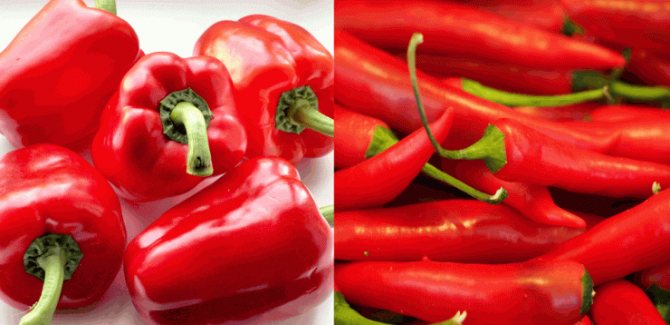

The benefits of bell pepper for weight loss
On weight loss diets, it is important to consume a lot of dietary fiber. This helps to cleanse the intestines of toxins, trigger a healthy peristalsis, and also feel full for longer, without resorting to frequent snacks throughout the day. Sweet bell peppers help a lot in this.
It can be used as a main ingredient in a meal to reduce the intake of starchy side dishes such as porridge and potatoes. Nutritionists recommend combining peppers with legumes to enrich the diet with protein. In addition, it is advisable to supplement the product with animal food: lean meat, eggs, as well as nuts and vegetable oils.
The consumption of pepper while dieting prevents depletion of the body, supplying the necessary vitamins for the full functioning of all systems. This keeps you active and in a good mood. The iron content ensures a normal blood composition, and phytosterols contribute to the elimination of excess fats.
The consumption of hot pepper during diets warms up the blood, speeds up metabolism and helps to burn extra pounds. But this must be done carefully: in small proportions and strictly with other food, so as not to harm the stomach.
Pepper helps maintain normal fluid circulation in the body, relieving swelling and helping to flush out all cells and systems. This is important on diets for restructuring the body to a new regime.
We advise you to read:
is it possible to eat radishes while losing weight
To read
Bulgarian pepper in cosmetology
Homemade masks with carotene can quickly rehabilitate even tired and dry skin. So, in a couple of minutes you can prepare several "rescuers".


Masks for very dry and irritated skin
Fresh pepper gruel is mixed with sour cream and carrot juice in a ratio of 1: 1: 1, 0.5–1 tsp will go to the face. Withstand such a mask for about 10 minutes, and when washing off, they do not use soap (to remove sour cream, you can wipe your face with a tonic). Repeat the mask 1-2 times a week until the skin stops “eating” the useful mass.
Protection against old age
To maintain skin elasticity and rejuvenate, 1 red pepper puree is mixed with a spoonful of honey and applied to the face for 20 minutes, then washed off with warm water. You must first make sure that there is no allergy to red pepper!
Strengthening hair roots
To saturate the hair and improve its growth, bell pepper juice is mixed with an egg and applied to the hair for 15–20 minutes, after which it is washed off with shampoo. The mask not only strengthens the hair, but also makes it shiny and soft.
Video:
11 Face Masks You Can Do In A Minute Expand
Sweet pepper treatment
Sweet peppers are successfully used in folk medicine:
- With stomatitis and gingivitis, they drink freshly squeezed juice, which has an anti-inflammatory effect.
- Juice with the addition of a tablespoon of honey is drunk in case of inflammation of the lacrimal sac.
- Regularly, vegetable juice should be consumed by those who have problems with the thyroid gland or iodine deficiency.
- Three times a day, before meals, pepper juice is drunk in 30-150 ml in case of deterioration of the pancreas, violations in the level of glucose.
- The tool is also suitable for external use - it is lubricated with age spots, while being mixed with carrot juice. The same mixture is used to get rid of eczema and dermatitis.
- Tincture helps to improve the condition with arthritis and rheumatism. For its preparation, unripe fruits are finely cut, placed in vodka or alcohol and insisted for 14 days in a place where the sun's rays and humidity do not penetrate.
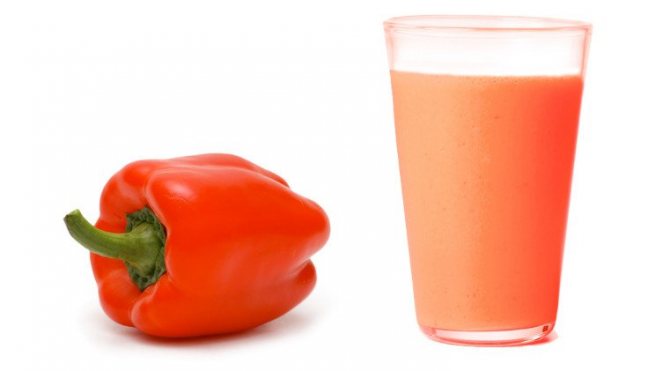

Harm and contraindications
Bell peppers often cause allergic reactions in people with sensitive skin. From a chemical point of view, the product does not cause serious harm, but sometimes it provokes a rash, fever, and tearing.
In particular, eating bright red or dark green peppers can lead to such a reaction - yellow and orange fruits are usually safe. Pepper seeds cause rejection, so it is advisable to thoroughly clean them before eating the vegetable.
Pepper has a number of obvious contraindications:
- severe liver or gallbladder disease;
- increased acidity;
- irritation and chronic diseases of the gastrointestinal tract;
- high blood pressure and heart rhythm disturbances;
- gout and other disorders of uric acid excretion;
- children's age up to 3, or even 5 years;
- period of menstruation, bleeding.
To prevent the pepper from causing flatulence and intestinal upset, it is necessary to use it in small portions, and in case of unpleasant symptoms, give preference to cooked peppers, rather than fresh ones.
Bell pepper allergy: symptoms
Bell pepper intolerance is most often expressed as a skin rash, fever, swollen lymph nodes, nasal congestion or tearing, itching in the intestines or on the skin, and unpleasant bloating. All of these symptoms can manifest themselves with varying degrees of severity at the same time or separately.
Symptoms can be similar to those of a cold or poisoning, and it is important to track them to see if they appear after eating the pepper. This is especially true for the health of young children, who have not yet begun to produce some enzymes for digesting plant proteins and other complex compounds.
Read also:


06 Mar 2019
Pear fruit gall midge (Contarinia pyrivora)
Pest type: Pests of fruit crops Row: Diptera - Diptera Family: ...
To read


06 Mar 2019
Decorative garden fountains and waterfalls
Waterfalls and fountains are a great decoration for any suburban area. ...
To read


06 Mar 2019
Red oak: description and photo of the tree
Botanical name: Red Oak (Quercus rubra), genus Oak, Beech family. ...
To read
How to choose and store bell peppers
When choosing fresh peppers, pay attention to the cuttings: they should not be dry. On the surface of the peppers there should be no wrinkles, indicating the loss of moisture, as well as damage.
Sometimes mold grows near the tails - it is better not to buy such a product, since the fungus spreads toxins throughout the fetus. It is also advisable to avoid peppers with too dense peel - this may indicate feeding with chemicals. A good fresh vegetable exudes a characteristic spicy aroma.
Store bell peppers in a vegetable vase at a temperature of 3-5 degrees for 1-2 weeks. Also, the product can be frozen or dried and ground into powder, then used as a seasoning.
Features of growing early varieties of sweet peppers
This thermophilic crop is traditionally grown through seedlings. The process begins in the last decade of February, if in the future it is planned to plant peppers in open ground, or in mid-February when transplanting seedlings into a heated greenhouse. This is due to the fact that pepper seeds germinate for at least 1.5–2 weeks. Before planting, to stimulate vegetative processes, it is recommended to soak pepper seeds in a saline solution (5 g per 1 liter of warm water) for 2-3 hours.
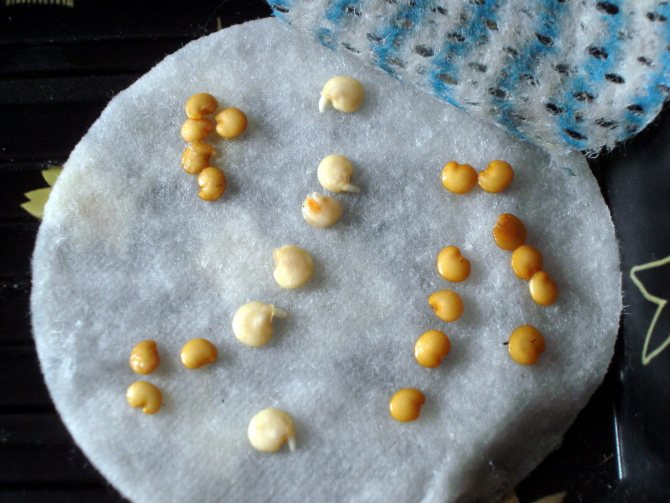

The pepper seeds are left on a damp cotton surface (cloth, gauze, cotton pad), after 24-48 hours the seeds are ready for planting
How to grow healthy pepper seedlings
Pepper seeds are planted in cups filled with 2/3 of a special soil mixture for seedlings or prepared soil from their own plot, mixed with humus and river sand in a ratio of 2: 1: 2:
- The seeds are dipped into the substrate to a depth of 1.5–2 cm, sprinkled and not tamped.
- The surface of the soil is slightly moistened and covered with glass, which will remain until the first "hairs" - sprouts appear.
- Crops are left in a room where the temperature is kept at least 20 ° C.
- Provide indirect sunlight or intermittent daylight illumination.


As young peppers grow up, liquid mineral fertilizing is introduced into the soil 1 time in 10 days (according to the instructions), this allows young shoots to get stronger and maintains immunity
Planting is periodically slightly irrigated with warm water and slightly loosened the surface of the soil with a thin stick.
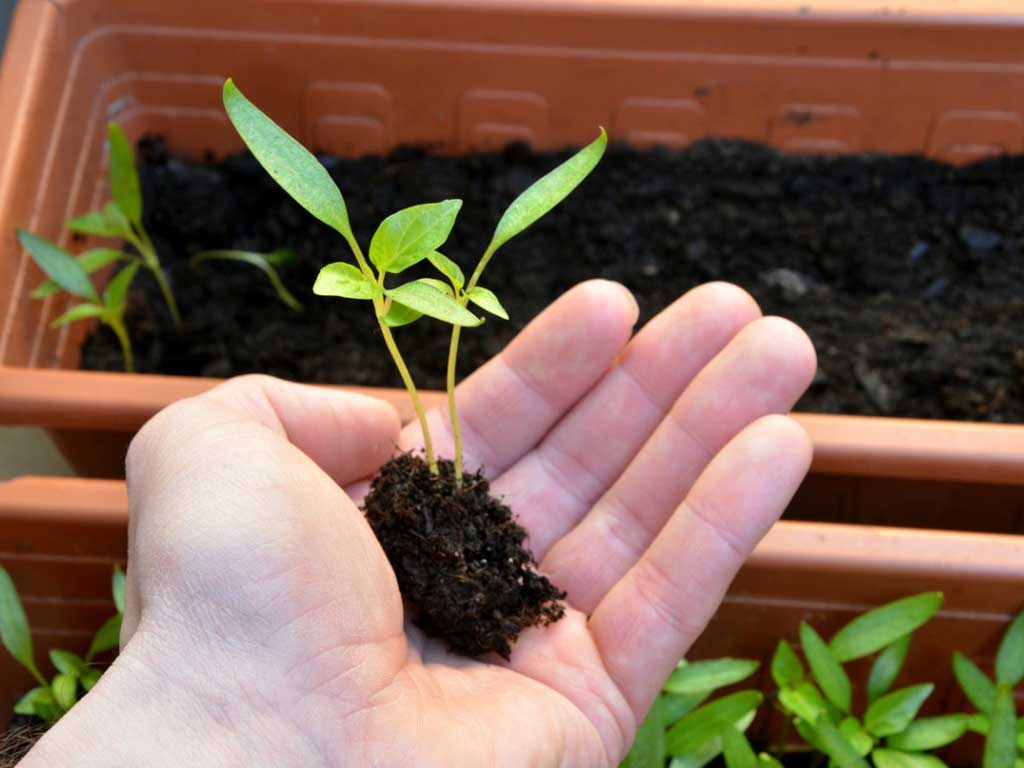

Seedlings grown in a large container dive at the stage of 2-4 leaves
We transplant peppers to the beds
After 50 days, when the seedlings form 8 to 10 leaves, they begin to harden. To do this, crops are taken out on the balcony or placed at a slightly open window (avoiding a direct draft). Around the third decade of May, when the night temperature does not drop below 10 ° C, young peppers are transplanted to a permanent place.
If the seedlings are in the greenhouse, during a cold snap, on the advice of experienced gardeners, we bring buckets of boiling water into the greenhouse, or put hot bricks heated over a fire on metal sheets.
Pepper planting algorithm:
- Shallow holes (15–20 cm) are prepared, placing them at a distance of 30–40 cm from each other.
- Each is filled with a handful of humus and one spoonful of wood ash.
- Then the hole is watered with warm water - 2-3 liters per root and the plant is lowered into it.


Pepper shoots are carefully lowered into the hole (leaving the cotyledons 1.5–2 cm from the ground) and sprinkled with loose soil, slightly compacting the surface
- The most important point for early peppers after transplanting is regular watering.
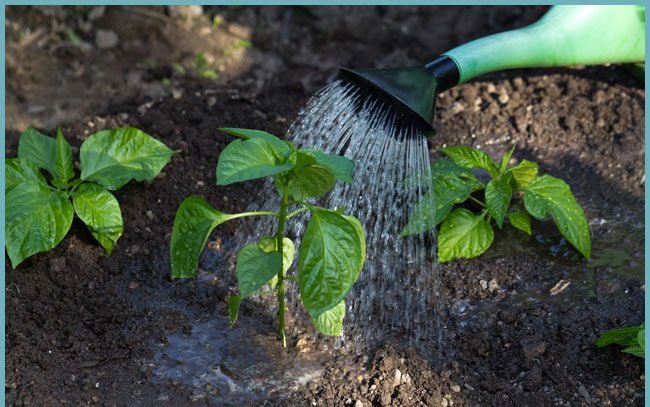

Seedlings are watered for the first 2 weeks every other day
What can be cooked from bell pepper: recipes
Besides adding fresh peppers to salads, vegetable stews and first courses, it is often chosen as a staple food. So, from sweet peppers, you can cook lecho in tomato or a steam garnish for fish. And here are some more recipes.
Stuffed peppers
Many people like this tasty second dish due to its fullness. It is suitable for the daily menu, even during fasting, and preparation does not take much time.
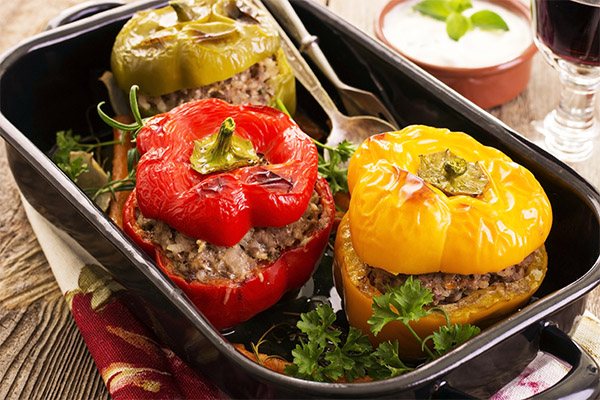

It is enough to boil the rice, fry the carrots and onions in a pan, if the dish is meat, add the minced meat there. If the filling is purely vegetable, add green peas and corn. Mix the finished frying with rice. Wash the peppers and remove the seeds. Stuff the base and simmer in a cauldron under the lid with the addition of tomato paste until tender.
Greek salad
The classic recipe excludes the addition of mushrooms or onions. You will need the following components:
- bell peppers red and yellow - 0.5 pcs.;
- tomato - 1 large;
- cucumber - 1-2 pcs.;
- lettuce leaves;
- feta cheese - 100 g;
- olives - 8 pcs.;
- cold pressed vegetable oil, salt, spices to taste.
The peppers are cut into half rings, and the remaining components are cut into large cubes, served chilled.
Asparagus Bean Snack
This recipe is convenient because you can cook a dish from frozen products:
- Bulgarian pepper (assorted) - 200 g;
- green beans - 200 g;
- leeks - 100 g;
- salt and spices to taste;
- vegetable oil.
Vegetables can be conveniently chopped and sautéed in oil. First, everything is brought to half-readiness over medium heat, and then simmer under the lid for a few more minutes. A nourishing dietary side dish is quickly ready.
Video:
5 bell pepper recipes Expand
Early sweet pepper varieties with description and characteristics
Sweet pepper (Bulgarian) is a popular vegetable crop grown by both summer residents and farms. The plant bears fruit successfully in open ground and in greenhouses in almost all regions of our country, provided that early and mid-early varieties are selected. Many cultivars are noted for their high tolerance to low temperatures, despite the fact that pepper is a thermophilic culture that is sensitive to sudden cold snaps.
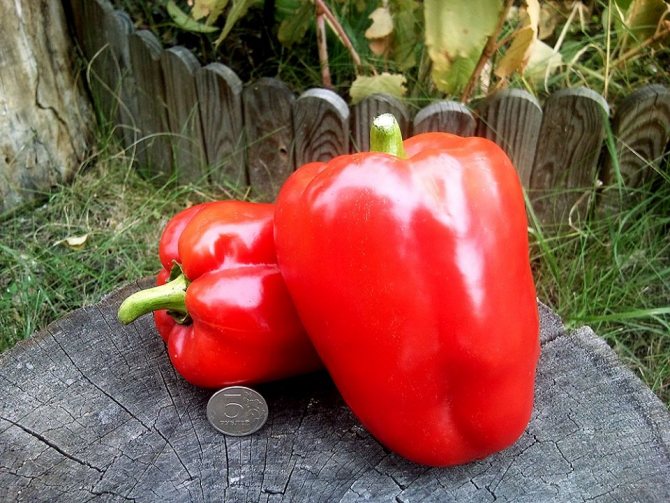

Modern ultra-early ripening pepper varieties are famous for their large-fruited and disease resistance
When choosing pepper seeds, they are guided not only by the appearance of the fruit, but also by other important characteristics:
- Pepper is divided according to the ripening period into early, mid-early, mid-season and late. It is best to grow varieties whose fruiting periods differ from each other, then fresh peppers from their beds will be right up to frost. Taking into account the climatic features of remote regions of our country, it is recommended to select, first of all, early-maturing varieties, the ripening period of which is 90-100 days.
- Since some varieties need an enhanced light regime, others are poorly adapted to cool weather and drought, varieties intended for growing under a film cover are singled out into a separate group. Peppers that are more resistant to weather anomalies grow and bear fruit remarkably in the open field.
- There are tall varieties - 90–120 cm, medium-sized ones - up to 80 cm, undersized ones - up to 60 cm - the so-called ratunda pepper (it is formed in the form of a compact bush and is unpretentious, in terms of fruiting time it often belongs to mid-season cultivars).


Regardless of the shape and color of the peel, the pulp of different varieties of peppers does not differ much in taste.
When choosing peppers, you should also remember that the color saturation of the peel indicated by the manufacturer will be different depending on the degree of ripeness of the fruit.
The type of maturity at which the fruits can be harvested for testing, for transportation and long-term storage is called technical. Biological maturity occurs at the moment of complete ripening of the pulp and seeds, the peppercorns acquire the varietal color and aroma indicated on the pack, but it is much more difficult to keep a fully ripe crop for future use.
The ideal option is to choose high-yielding zoned hybrids of an early ripening period and purchase planting material only from trusted sellers. More than 500 varieties are presented in the State Register of Breeding Achievements, among them almost half are early maturing. Below is a description of cultivars, the yield of which is not less than 4–4.5 kg / m2.
Super early varieties of sweet peppers
The very first early ripening varieties of pepper are ready for picking within 85–90 days from the moment of planting.
The ultra-early varieties include Zhupsky early for open ground, which begins to ripen 90 days after sowing. The height of the bush is no more than 60 cm. The cultivar is valued for its resistance to many diseases and versatility of use. The variety has a delicate taste, suitable for fresh salads and appetizers. It is possible to collect up to 9 kg of selected fruits from 1 m2.


Early ripening Zhupsky early is the first of the peppers to delight with its harvest, its cone-shaped fruit with a bright red peel at full maturity is capable of gaining 100-120 g
Dobryak - the earliest (according to the State Register) of sweet peppers, fully ripens on the 95th day, and you can eat it for the first time in 70–75 days from the moment the first shoots appeared. In addition, it is a thick-walled hybrid: 9-10 mm - the thickness of the fruit wall, weight - 110 g. The cultivar is resistant to top rot and bears fruit well, according to official data, it can give up to 12.5 kg / m2 per season.
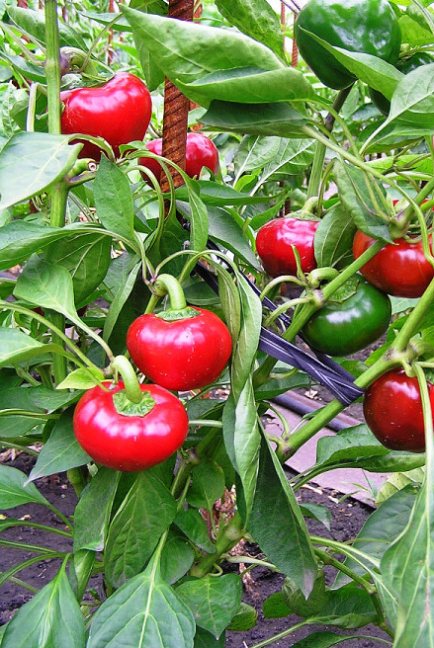

Red round peppers of the Dobryak variety densely cover the bush
Pinocchio F1 is the best pepper for indoor ground with a ripening period of 88 days from the date of sowing. It has a high yield (14 kg / m2). The average weight of pepper is 115 g. Spreading bush, about 55-60 cm high, the plant does not require formation, is distinguished by persistent immunity, but sometimes suffers from apical rot of the fruit.
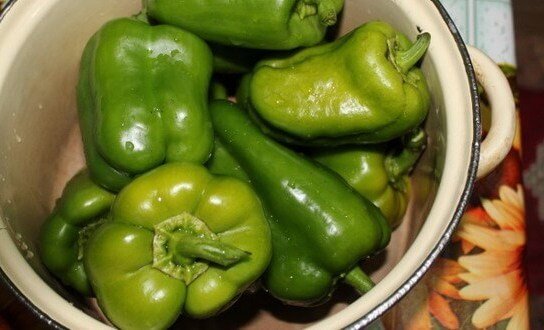

Buratino F1 is not very noticeable, its elongated thin-walled fruits (4 mm) remain dark green even when ripe, but they perfectly emphasize the taste of first courses and sauces for side dishes
An early bird - feels good both in the beds and in greenhouses, it begins to bear fruit already 90 days after planting. With a low yield - 4 kg / m2 - bears fruit until the last summer days in the middle lane and is able to painlessly tolerate drought and damp weather. On average, glossy, conical, slightly flattened on top, fruits gain 110 g, have a rich crimson color.
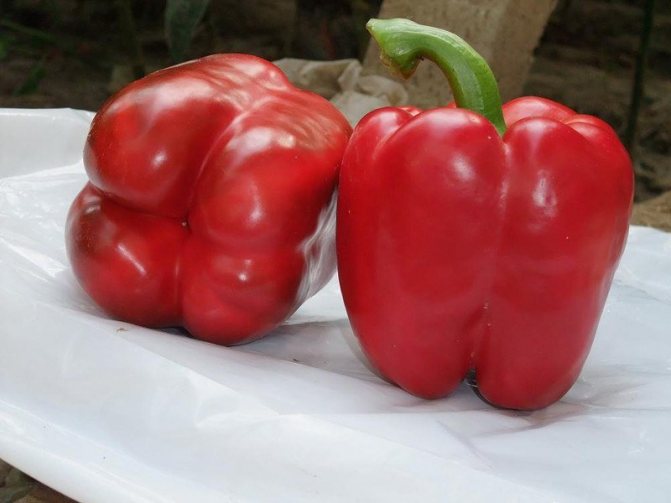

Pepper Early bird with appetizing ruddy sides is grown for salads and for preparing snacks for the winter, the thickness of the walls of its pulp is about 5 mm
A novelty of the outgoing year - Chocolate handsome. A vigorous, spreading bush is capable of producing up to 8 kg / m2 of selected brownish cylindrical fruits (weight 100–130 g) per season. The thickness of the walls of the pulp is almost 7 mm, which means that the pepper is perfect for snacks, dressings and even stuffing. The chocolate beauty is versatile in use and perfectly adapts to any climate conditions.
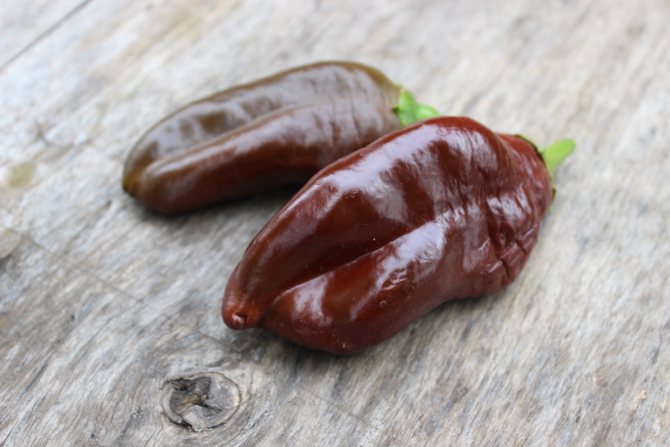

The first fruits of the Chocolate Handsome variety ripen about 95 days after sowing, the variety is distinguished by a friendly return of the harvest and almost does not suffer from top rot
Table: other ultra-early sweet peppers
| Variety name | Fruit shape and color | Weight, g | Wall thickness, mm | Productivity, kg / m2 | Growing conditions: open ground - OG, greenhouse - T |
| Nikitich | Prismatic, red. | 90 | 5 | 4 | OG |
| Health | Red, elongated. | 60 | 4 | 5–7 | T |
| Cardinal F1 | Cuboid, purple. | 250–280 | 8–10 | 6 | OG |
| Ruza F1 | Conical, red. | 35–50 | 4–5,5 | 5–13 | T |
| Fidelio F1 | Cuboid, light yellow. | 180 | 7–8 | 4–6 | T |
| Jubilee Semko F1 | Prismatic, red. | 130 | 5–6 | 6, 11 | T, OG |
| Candy F1 | Flat round, bright red. | 40–50 | 6–7 | 4 | T |
| Snowball F1 | Conical, bright red. | 60–100 | 5 | 11, 5 | T, OG |
| Bullfinch F1 | Rounded, red. | 75–120 | 7,5 | 13 | T |
| Oriole | Heart-shaped, with a sharp top, yellow. | 64–85 | 4–7 | 6–14 | T |
| Golden Rain | Lemon yellow, with a concave top. | 50–60 | 7 | 4–6 | OG |
| cabin boy | Conical, red. | 180 | 7 | 6,5 | OG |
| Tosha | Elongated, dark scarlet. | 70 | 6 | 10 | T, OG |
| Orange Wonder F1 | Cuboid, orange. | 210 | 9 | 10 | OG, T |
| Nagano F1 | Cuboid, red. | 160 | 8 | 14 | T |


Medium-sized bushes of the Golden Rain pepper variety look like appetizing fruits, medium-sized fruits with a wide base are convenient to stuff
Which early maturing pepper to choose for open ground
For 30 years, the prolific Topolin with compact bushes (55–65 cm) has been pleasing the gardeners of our country with bright red fruits with a sharp tip, they weigh almost 90 g, the thickness of the walls of the pulp is from 4 to 5.5 mm. The excellent taste of the Topolin variety, excellent immunity to black mold and bacterial wilting of peppers makes summer residents fall in love with an early-ripening cultivar in absentia. The first crop can be harvested 103–110 days after planting.
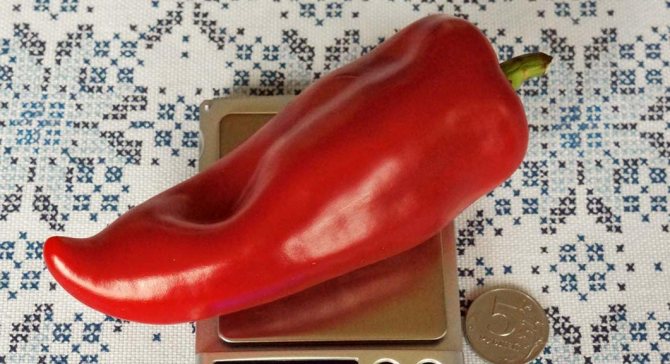

The yield of the Topolin pepper variety is 5.5 kg per square meter, in technical ripeness it can be stored for up to 3 weeks
Belogor F1 with cuboid, highly glossy bright red in technical ripeness and dark scarlet fruits - in the biological one, summer residents of the middle zone, the North-West and Transbaikalia will definitely like it. The variety is resistant to low temperatures, versatile in use. The average weight of the peppers is almost 130 g, the wall thickness is 6 mm. It is noted that Belogor F1 practically does not suffer from apical rot.


The large-fruited hybrid Belogor F1 with crispy dense pulp has an excellent presentation and is well stored, the marketability of the fruits does not decrease during transportation
The eaglet is removed for testing after 93 days from the moment the first shoots appear. Prismatic red-coral fruits with a fleshy center (flesh thickness 5–6 mm) do not exceed 100 g, suitable for stuffing, preservation and preparation of snacks. In hot summers with abundant rains, summer residents achieve excellent yields in the open field - almost 9.5 kg / m2.


The eaglet has a delicate skin, it is responsive to watering, rarely gets sick and is distinguished by abundant formation of fruits
Table: varieties of early peppers for open ground
| Variety name | Fruit shape and color | Weight, g | Wall thickness, mm | Productivity, kg / m2 | Plant height |
| Abigal F1 | Narrow conical, red. | 65–100 | 5,5 | 4–6 | 45-60 cm |
| Andreyka | Yellowish red, elongated. | 140 | 5–6 | 4,2 | up to 1 meter |
| Belladonna F1 | Cuboid, light yellow. | 120–140 | 5–7 | 4,5 | up to 45 cm |
| Czardas | Conical, with a spout, orange. | 170–220 | 6 | 8 | 70 cm |
| Santa Claus | Cylindrical, dark red. | 100–120 | 6–7 | 8,2 | 50-60 cm |
| Alexy | Light red, elongated. | 180–200 | 5–7 | 4,5–7 | 60-80 cm |
| Golden pyramid | Conical, yellow. | 102 | 6–8 | 6,7 | up to 70 cm |
| Romeo F1 | Dark yellow, cylindrical. | 90 | 6 | 10 | 60-70 cm |
| Aristocrat | Dark red, elongated. | 80 | 7–8 | 4 | 90-110 cm |
| Yellow bouquet | Cylindrical, yellow. | 150 | 7,5–8 | 6 | about 65-70 cm |
| Annushka | Dark red, prismatic. | 110 | 5 | 7 | up to 80 cm |
| Sun | Flat-round, orange. | 85 | 5 | 8 | 60 cm |
| Hussar F1 | Red, prismatic. | 80–90 | 5–6 | 4,9 | 65-70 cm |
| F1 white filling | Conical, red. | 140 | 7 | 6,7 | up to 45 cm |
| Apollo F1 | Conical, red. | 80 | 6 | 7 | 50-60 cm |
| Znayka | Heart-shaped, red. | 260 | 10 | 6,7 | 1.5m high |
| Big jackpot | Cylindrical, red. | 200–250 | 7–8 | 6,9 | 75 cm |
| Galatea | Slightly ribbed, elongated, dark orange. | 130–150 | 6 | 6,6 | 75-80 cm |
| Vityaz F1 | Cone-shaped, dark red. | 100–120 | 8 | 7,2 | 60-70 cm |
| Garland | Narrow conical, red. | 150 | 7 | 7,3 | 90 cm |
| Honey King F1 | Cylindrical, yellow. | 180 | 7,5 | 6,7 | 60-80 cm |
| Prodigy | Blunt-conical, orange. | 220–330 | 6 | 5,6 | 50-75 cm |
| Gromozeka F1 | Square, brownish orange. | 250 | 7–8 | 9,1 | 65-70 cm |
| Little Red Riding Hood | Dark red, cuboid. | 200 | 7 | 9,5 | about 50 cm |
| Daria | Conical, red. | 96 | 5 | 7 | up to 50 cm |
| Emperor F1 | Conical, red. | 150 | 6–8 | 4,5 | 60 cm |
| Zlatozar | Elongated, yellow. | 80 | 6 | 5 | more than 1 m |
| Kazachok | Red, tapered. | 110 | 7 | 4,7 | 40 cm |
| Corvette | Elongated, dark red. | 120 | 7,5 | 4,6 | 55-60 cm |
| Mascot | Elongated, burgundy. | 170 | 8 | 5,6 | 60-80 cm |
| Siberian prince | Conical, red. | 80–95 | 5–6 | 10 | 90-130 cm |
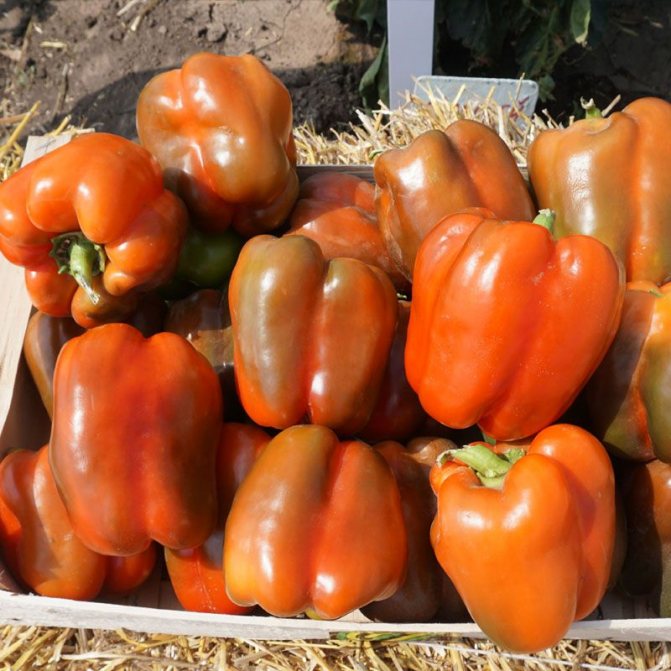

An unimaginable multitude of early ripening varieties of peppers hides fruits of the most incredible shapes and shades, for example, pepper with the interesting name Gromozeka F1
The best cultivars suitable for greenhouse cultivation
Red-fruited medium-sized (50 cm) Agapovsky with compact bushes in a temperate continental climate matures already at the end of June (99–120 days before technical ripeness). The wall thickness is no more than 6 mm, while the average weight of ripe fruits is about 110 g. The variety is resistant to tobacco mosaic.
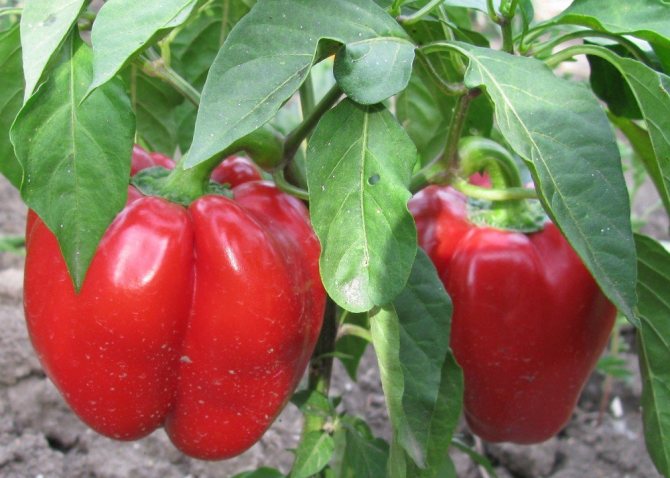

The average yield of Agapovsky pepper reaches 10 kg per square meter, it is perfect for making lecho and dressing for borscht
Greenhouse Bendigo F1 with 100-gram fruits is grown not only by summer residents, but also by farmers on an industrial scale, since the yield of the cultivar reaches 10-15 kg / m2. The fruits are cuboid, dark red, slightly flattened and concave in the middle, perfect for baking, stews and freezing. The cultivar is cold-resistant and tolerant to the tobacco mosaic virus.
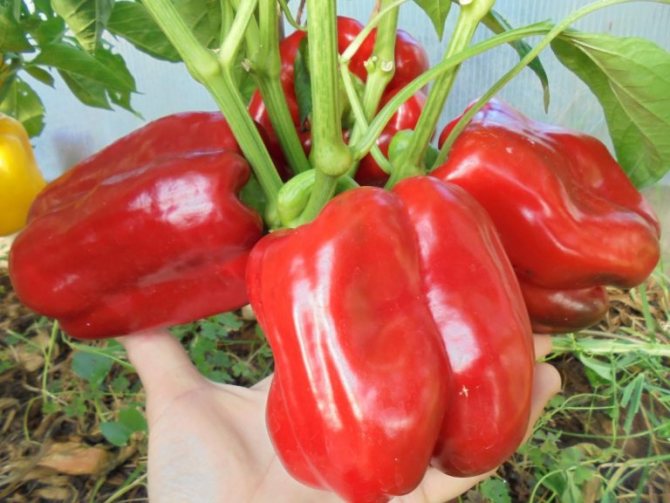

Bendigo F1 is loved for its incredible yield and the unique taste of delicate pulp
The technical ripeness of the Krepysh variety begins on the 103rd day after full germination. The red-orange variation of the color of the pointed peppers sticking up on the bushes is most familiar to this cultivar, but it is quite sweet and juicy at the stage of dyeing the peel yellow. Fully ripe fruits gain 70–75 g each, the wall thickness does not exceed 6 mm. The maximum yield is about 4.2 kg / m2. The variety is susceptible to verticillary wilt.


By the content of ascorbic acid, Krepysh pepper is 2 times higher than other early maturing varieties
Table: varieties of early maturing peppers that bear fruit best in greenhouses
| Variety name | Fruit shape and color | Weight, g | Wall thickness, mm | Productivity, kg / m2 | Plant height |
| Yarik | Conical, yellowish. | 45–50 | 4 | 6,5 | up to 80 cm |
| Sorcerer | Flat-round, ribbed, red. | 160 | 7 | 7–12 | up to 90 cm |
| Swallow | Oval, light green. | 53–79 | 5,5 | 4,7 | 60-70 cm |
| Snow White | Conical, red, with a blunt apex. | 80–94 | 7 | up to 7 | 50 cm |
| Gemini F1 | Cylindrical, yellow. | 80–206 | 5,5–7 | 4–5 | 55-60 cm |
| F1 adept | Cuboid, bright orange. | 110 | 6 | 5,9 | 55 cm |
| Bagration | Flat round, yellow. | 150–200 | 7–8 | 5,7 | 60 cm |
| Amber | Conical, orange. | 90–110 | 6,5 | 4–7 | up to 1 m |
| Vaudeville | Prismatic, red. | 230–300 | 6–7 | 7,2 | 1.2-1.5 m |
| Hannibal | Prismatic, brown. | 140 | 5 | 9,1 | 80 cm |
| Chrysolite F1 | Conical, red. | 150 | 5 | 12 | more than 1 m |
| Antiquary | Red, ribbed, prismatic. | 220–280 | 5–7 | 8,3 | up to 2 m |
| Wonder Giant F1 | Narrow conical, dark red. | 180 | 6–7 | 7,8 | 1.2-1.4 m |
| Funtik | Conical, red. | 190 | 7 | 6,7 | up to 60 cm |
| California miracle | Cuboid, red. | 120 | 5–8 | 4–7 | 60-70 cm |
| Smile | Conical, red. | 230 | 7 | 6,2 | 1.3 m |
| Pace F1 | Prismatic, red. | 160 | 6–7 | 8,6 | 60-75 cm |
Video: the earliest and super-yielding peppers for greenhouses
Early thick-walled sweet pepper varieties and hybrids
Early miracle F1 is indispensable for stuffing and fresh summer salads, the thickness of the flesh wall is 10-11 mm. Elongated carmine-red fruits can grow up to 250 g, with an average crop yield of 14 kg / m2. High - up to 1.2 m - the plant grows well both in the beds and in indoor greenhouses, but it must be formed and tied up.
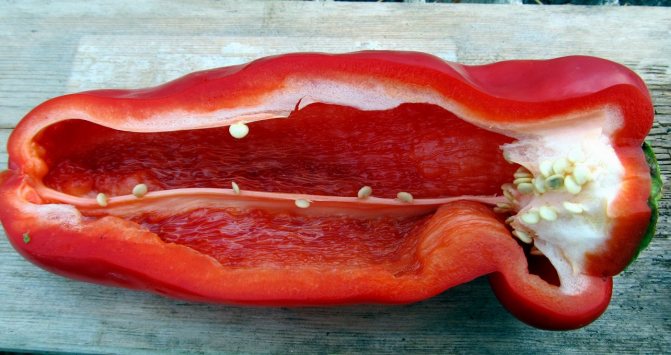

The early miracle of F1 is attributed to salad hybrids, it almost does not suffer from top rot and easily tolerates drought
Gingerbread man is a variety that many gardeners fell in love with 30 years ago. On a compact bush (30 cm), round, dense, at the same time juicy fruits with a pulp thickness of up to 10–12 mm are formed. Over the decades, summer residents have become convinced that Kolobok is rarely affected by anthracnose and summit rot.


The gingerbread man is a real thick-walled pepper, it has no equal for preservation and salads, it gives unprecedented harvests (up to 7-9 kg per square meter) in the open field
On closed, medium-sized bushes of the Alkmaar F1 hybrid, prism-shaped dark red fruits weighing up to 270-300 g grow. The fruit wall thickness can exceed 10 mm. The variety is plastic and easily adapts to the conditions of a harsh climate, heat-resistant, well-kept, immune to diseases of vegetable crops.


Pepper Alkmaar F1 is a thick-walled red-sided hybrid of universal purpose, the yield of which under film shelters reaches 10 kg per square meter, in the beds - 2-4 kg less
Table: varieties of thick-walled sweet peppers that ripen earlier than other cultivars
| Variety name | Fruit shape and color | Weight, g | Wall thickness, mm | Productivity, kg / m2 | Growing conditions: greenhouse - T, open crimp - OG |
| Chord | Trapezoidal, red. | 190 | 7–8 | 7 | T |
| Alesya | Prismatic, dark red. | 160–180 | 8–9 | 8,5 | T, OG |
| White Night | Conical, yellow. | 130 | 9 | 10, 8 | T, OG |
| Jack | Elongated, dark orange. | 164 | 8–9 | 6,3 | T, OG |
| Golden barrel | Cuboid, dark yellow. | 170–200 | 8–9 | 8,5 | OG |
| Aramis F1 | Prismatic, ribbed, deep red. | 230 | 8–9 | 7,8 | T, OG |
| Carat | Dark red with a violet tinge, prismatic. | 70 | 8 | 4,9 | T, OG |
| Golden swallow | Heart-shaped, yellow. | 130 | 9 | 5,6 | OG |
| F1 Attack | Bright red, cuboid. | 140–160 | 10 | 3,8 | T |
| Budulay F1 | Square, brown. | 250 | 9 | 8,8 | T, OG |
| Knyazhich F1 | Cylindrical, yellowish red. | 210 | 8–9 | 6,9 | OG |
| Aphrodite | Prismatic, dark yellow. | 210 | 10 | 7,7 | T, OG |
| Fat Baron | Cone-shaped, dark red. | 160 | 10–11 | 3 | T |
| Sudarushka | Flat-round, red. | 80 | 10 | 8,7 | T |
| Ruby necklace | Round, red. | 80–95 | 8,5–9 | 8,6 | T, OG |
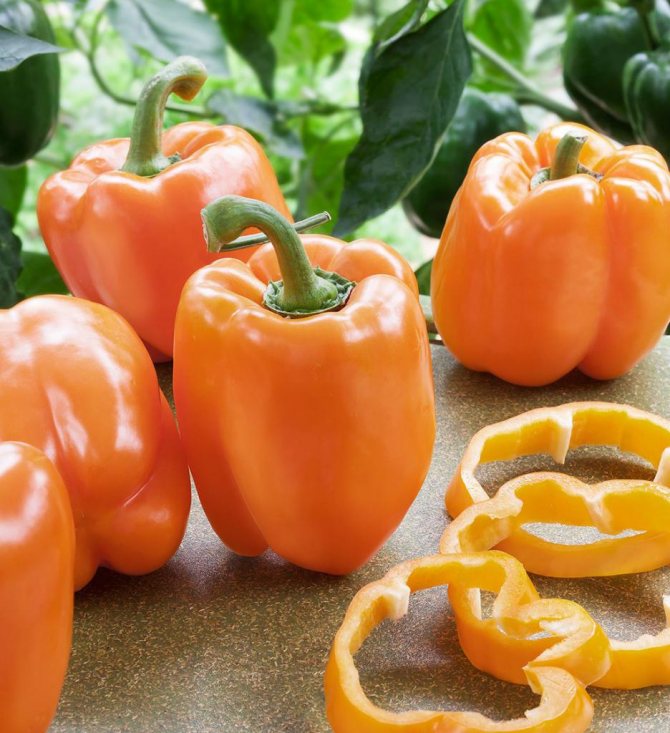

Pepper Jack with a delicious glossy skin and juicy pulp is similar to an orange
Separately, we can note the varietal novelties of pepper, this is especially true for those who love fruits of an unusual shape and color and annually replenish the stock of seeds, taking into account the latest achievements of breeding.
Table: varieties of early peppers approved by the State Sort Commission of the Russian Federation in 2018
| Variety name | Fruit shape and color | Weight, g | Wall thickness, mm | Productivity, kg / m2 | Growing conditions: greenhouse - T; open ground - exhaust gas |
| Yekla F1 | Cuboid, bright red. | 250–300 | 8 | 4,5 | T, OG |
| Quickly F1 | Prismatic, red. | 120 | 7 | 8,6 | T, OG |
| Edros F1 | Narrow conical, light red. | 140 | 7 | 6,4 | T, OG |
| Ruby gourmet | Conical, red. | 40–50 | 5,5 | 5 | T |
| Lumos F1 | Cuboid, yellow. | 200 | 4–5 | 4,5 | T |
| Mystic | Square, brownish red. | 100 | 10 | 6,8 | T, OG |
| Heavyweight | Cuboid, dark yellow. | 200 | 10 | 8,5 | T, OG |
| Silver Star F1 | Red, cuboid, finely ribbed. | 170 | 5 | 6,7 | OG |
| Red Cat | Rectangular orange. | 160 | 9 | 7,8 | T, OG |
| Fantastic F1 | Cuboid, yellow. | 200 | 6 | 5,7 | T |
| Cheerful neighbor | Cylindrical, yellow. | 106 | 5–8 | 4 | T |
| Hellas | Conical, light red. | 140 | 6 | 6 | T, OG |
| Ferrari F1 | Cuboid, red. | 130–160 | 5 | 7,6 | T |
| Golden Ataman F1 | Cuboid, orange. | 200 | 7 | 5,5 | T, OG |
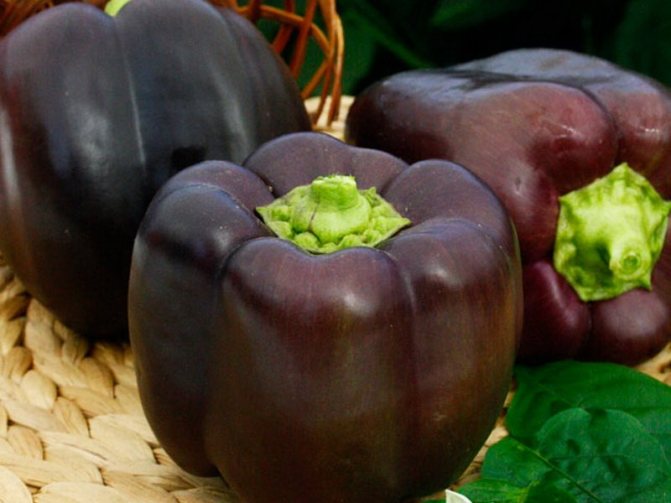

Thick-walled Mystic pepper at full maturity has a very rich brownish-burgundy peel
Pepper varieties for regions
More than half of the early-maturing varieties allowed for use can be grown anywhere, while most of the cultivars in the above sample successfully bear fruit both in closed film greenhouses and in open beds.
What early maturing varieties are advised by summer residents of the North-West of Russia
Some of the best in terms of yield and resistance to low temperatures are:
- Agapovsky,
- Belogorets F1,
- Pinocchio,
- Ruza F1,
- Siberian F1,
- Snowball F1.
Most adapted to cool, damp summers:
- Swallow,
- Strong man,
- Romeo F1.
Video: what early varieties of sweet peppers to choose for the North-West of Russia
Choice of gardeners in Central Russia
Summer residents of the Central Black Earth Region and the Volga Region claim that the best early peppers are:
- Bendigo F1,
- Blondie F1,
- Winnie the Pooh,
- Nikitich,
- Zolotinka F1,
- Wizard,
- Nagano F1,
- Ruza F1,
- Chrysolite F1.
Some of the presented cultivars are distinguished by high returns and bear fruit until the September cold weather.
Video: the best peppers cultivated in the Central Federal District
Early pepper varieties for the southern regions of our country
Excellent students of the southern climate:
- Arsenal,
- Barbie F1,
- Thank you,
- Corvette,
- Slavutich,
- Topolin.
The incomparable taste in lecho, borsch dressings and summer salads does not allow the gardeners of the Krasnodar Territory and the Caucasus to abandon these cultivars in favor of new products suitable for a warm climate.
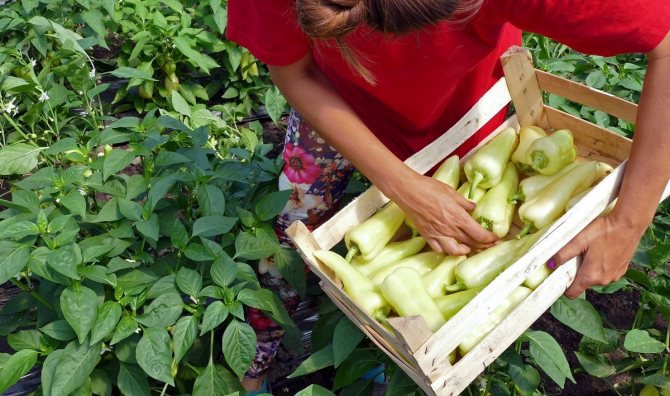

The hot climate is favorable for the cultivation of bell peppers; in the south, the earliest harvests of early ripening varieties of this vegetable crop are obtained.
What kind of pepper is grown by summer residents in the harsh climate of Siberia and the Far East
The northern region prefers varieties of such early maturing peppers as:
- Valentine card,
- Viking,
- Oriole,
- Alkmaar F1,
- Strong man,
- Merchant,
- Romeo F1,
- Siberian prince,
- Sudarushka.
They are ideal for growing in unpredictable climates, do not reduce yields in the open field during a sudden cold snap in June.

